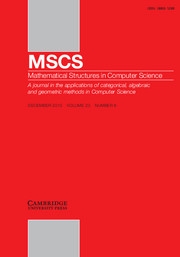Article contents
Ordered combinatory algebras and realizability†
Published online by Cambridge University Press: 10 September 2015
Abstract
We propose the new concept of Krivine ordered combinatory algebra (  $\mathcal{^KOCA}$ ) as foundation for the categorical study of Krivine's classical realizability, as initiated by Streicher (2013).
$\mathcal{^KOCA}$ ) as foundation for the categorical study of Krivine's classical realizability, as initiated by Streicher (2013).
We show that  $\mathcal{^KOCA}$ 's are equivalent to Streicher's abstract Krivine structures for the purpose of modeling higher-order logic, in the precise sense that they give rise to the same class of triposes. The difference between the two representations is that the elements of a
$\mathcal{^KOCA}$ 's are equivalent to Streicher's abstract Krivine structures for the purpose of modeling higher-order logic, in the precise sense that they give rise to the same class of triposes. The difference between the two representations is that the elements of a  $\mathcal{^KOCA}$ play both the role of truth values and realizers, whereas truth values are sets of realizers in
$\mathcal{^KOCA}$ play both the role of truth values and realizers, whereas truth values are sets of realizers in  $\mathcal{AKS}$ s.
$\mathcal{AKS}$ s.
To conclude, we give a direct presentation of the realizability interpretation of a higher order language in a  $\mathcal{^KOCA}$ , which showcases the dual role that is played by the elements of the
$\mathcal{^KOCA}$ , which showcases the dual role that is played by the elements of the  $\mathcal{^KOCA}$ .
$\mathcal{^KOCA}$ .
Information
- Type
- Paper
- Information
- Copyright
- Copyright © Cambridge University Press 2015
Footnotes
This work was partially supported by ANII (Ur), CSIC (Ur), IFUM (Fr/Ur), ANR (Fr).
References
- 6
- Cited by

